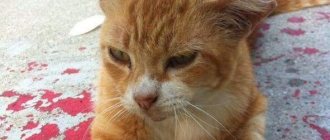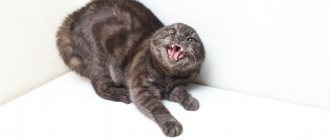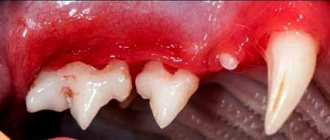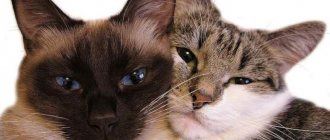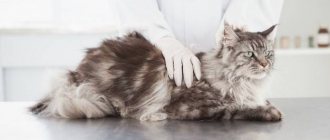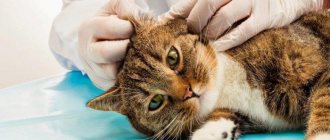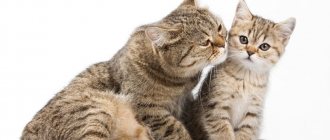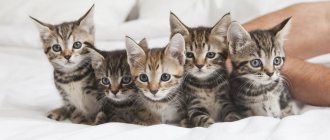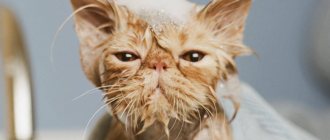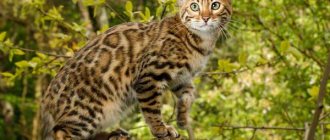How do cats express emotions?
Contents hide
Eyes . By looking you can determine different shades of your pet’s mood:
— a gaze (the cat is looking for your eyes) communicates that the pet wants attention, communication and friendship;
— dilated pupils with a sufficient amount of light signal the animal’s fear and excitement;
- constricted pupils indicate determination and aggression;
- wide-open eyes express curiosity, amazement;
- if a cat squints, opening and closing its eyes, it means that it is calm and peaceful.
Ears . Movable ears show the cat’s mood well:
- directed upward, standing upright - playfulness, attention, curiosity, happiness;
- separated to the sides - wariness, distrust, irritation (it is better to leave the cat alone);
- directed backwards - aggression, readiness to attack.
Torso . With the help of body language, the pet demonstrates its willingness to communicate. An arched back, a tucked or fluffed tail with a hook, pinned ears - all this indicates that the cat is unfriendly, scared and ready to attack. On the contrary, a cat stretched out in front of a person, showing his belly, demonstrates trust and goodwill.
Cats express their resentment by sitting with their backs or sides to a person. At the same time, cunning pets try to stay in sight. This behavior shows that the cat feels abandoned and perhaps wants to appeal to the owner’s conscience. Take your pet in your arms, pet it, call it to you. Show that you always remember your beloved cat.
Paws . Cats perceive humans as members of the pride in which they live. According to the laws of nature, odors distinguish one group from another. Therefore, the pet marks the apartment, favorite things and all household members.
Cats do this with the help of scent glands located in the groin, near the ears, on the lips and on the pads of the paws. That is why the pet rubs its head, climbs to “kiss” and crushes the household with its clawed paws. This is how the cat demonstrates that the person is one of his own, dear, important.
In addition, a “massage” accompanied by purring shows that the cat is happy, content and calm. There is an opinion that this is how the pet returns to childhood, when it blissfully sucked milk, stimulating the mammary glands with its paws.
Tail . A fluffy tail is the main compass of a cat’s mood:
- raised up - self-confidence, pride, good mood;
- fluffy (reminiscent of a brush) - rage;
- movingly waving - irritation;
- floor moving smoothly from side to side horizontally - confusion, difficult choice;
- lowered - boredom;
- twitching tip, trembling tail - anticipation of the hunt (preparing to catch “prey”) or excitement;
- slightly moving tip - good mood, joy, peace;
- wrapped around the body (tail in a “ring”) - trust, peace;
- half-raised - misunderstanding of attitude towards oneself;
- knocking on the floor - stress, pain, severe irritation;
- “pipe” with a relaxed tip - joy, mischief.
Kittens often wag their tails in a similar way to dogs. Unlike irritated adult cats, babies express happiness this way, especially if they rub against their owner’s legs at that moment.
Meowing . Cats do not communicate with each other by meowing. Large representatives of the cat family make various sounds in nature to call their cubs, scare off competitors or call for help. In the process of evolution, pets have learned to give signals specifically to humans.
By the timbre of the voice and the pitch of the sound, you can determine what exactly the cat wants to “say.”
A quiet meow, reminiscent of a drawn-out “me,” is aimed at attracting attention. The cat wants to be played with, petted or fed. If a person does not pay attention to the call, the pet can use gestures: touch it with its paw, jump on its lap, lie on the laptop.
A repeated loud “meow” signals a problem. The cat requires action from a person that will solve a complex problem. You may need to open the door to let your cat outside for a walk or to let him into your bedroom.
A plaintive drawn-out “mau” is the sound of help. That's what cats scream when they can't get out of a trap. A cat may make this sound when it is scared and cannot find its bearings or go to a safer place.
After living with a cat, many owners begin to understand their pet without prompting. Don't ignore emotions, watch your mood. Then it will be easier to make your beloved cat truly happy.
Photo source:
Scientists have discovered who understands cat emotions
The emotions of cats are difficult to understand, but some people are able to surprisingly accurately interpret the expressions of cat faces, Canadian experts from the University of Guelph have found. They talked about this in an article in Animal Welfare
.
Although cats are no less popular as pets than dogs, they have been studied much less well, the authors of the work write. The entire understanding of cat emotions comes down to such manifestations as hissing, raising fur, pressing ears and other signs of aggression. People cannot determine the emotional state of a cat by its meowing, and cannot understand from its facial expressions whether it is in pain or not. However, research has shown that some people are better at recognizing cat emotions than others, so scientists decided to look into this issue in more detail.
“The ability to read animal expressions is critical to their well-being.
We've found that some people are very good at recognizing cats' emotions. This shows that these skills can be taught to more people,” says Professor Lee Neal, lead author of the study.
Until now, the only research that has looked at emotion in cats' faces has been a study of pain expressions.
“Our study is the first to look at assessing a wider range of negative emotional states in animals, including fear and frustration, as well as positive emotional states,” adds Professor Georgia Mason, co-author.
More than 6,300 people from 85 countries participated in the study. 93% of them had owned cats at some point in their adulthood, and 80% were living at home at the time of the study. They had to watch 20 short online cat videos from a collection of 40 videos collected mostly from YouTube and fill out online questionnaires.
close
Universities Federation for Animal Welfare
“We have proven that the Internet and cats are a powerful combination,
- researchers joke. “YouTube has proven to be a rich source of cat videos, and more than 6,000 participants completed our online survey in just ten days.”
The cats in the video experienced either positive emotional states (such as when they were petted or given treats) or negative emotional states (such as when they were experiencing health problems or were in situations that caused them to retreat or run for their lives). Each video focused on the cat's face. None of the cats showed fearful expressions such as bared fangs or flattened ears, as these features are already widely known.
Participants had to answer whether the cat was experiencing positive emotions, negative emotions, or whether they found it difficult to answer.
For most participants, the test was difficult. The average score was 12 out of 20—slightly above chance.
But 13% of participants showed very good results, scoring 15 points or more. More often they were women and veterinarians. Young people also performed the task better.
“The fact that women performed better overall than men is consistent with previous research that has shown that women are better at reading nonverbal expressions of emotion in both humans and dogs,” says Mason.
However, love for cats in itself did not contribute to obtaining higher scores.
The fact that some people can read a cat's emotions shows that others can be taught to do the same, the researchers note.
“This is important because it can help strengthen the bond between owners and cats and thus improve the care and well-being of cats,” says Neal.
Previously, Russian veterinarians said
about what diseases domestic cats most often suffer from.
It turned out that animals in Moscow suffer most from obesity, urolithiasis, as well as allergies and dermatitis, which are caused by the pet’s poor diet.
The most common infectious diseases were calcivirosis and panleukopenia. Maine Coon, Sphynx and Bengal cats are most often brought to see a veterinarian.
Experts noted that it is important to carefully monitor the diet of any pet, as well as vaccinate the animal in a timely manner.
Fear
Fear is one of the most powerful reactions, since it is generated by the instinct of self-preservation and is associated with a powerful hormonal release in the body. This feeling makes one literally turn to stone on the spot, and the whole cat’s face turns out to be the personification of the saying: “Rhinestone has big eyes.”
Externally, fear is expressed:
- increased muscle tone;
- stiffness of movements;
- head pulled into shoulders;
- rounded eyes, widely dilated pupils;
- ears down;
- with its tail between its legs (read the article on how to understand a cat by its tail).
A frightened cat is silent or makes abrupt, muffled sounds.
Ready for battle
Cats are very cautious animals, so in a dangerous situation they choose to camouflage and wait, or flee.
However, when cornered, they fight back using their natural arsenal of 20 hooked claws and fanged mouths. A cat ready to fight signals its serious intentions:
- deep visual concentration on the opponent;
- ears pressed to the back of the head;
- bared mouth and hissing;
- strikes with the front paw with extended claws;
- tipping over onto your back with half-bent tense legs;
- a drawn-out battle cry;
- lightning jump attack.
Anger
Irritability can quickly turn into anger if the animal is not left alone. Increased negative emotions are indicated by:
- tail moving with a large amplitude from side to side;
- ears pressed to the head;
- point-blank gaze;
- front paw raised for protection;
- arching of the back;
- hiss;
- angry guttural sounds similar to howling.
How to tell a cat's mood by its facial expression
Expressive large eyes, movable ears that can rotate 180° and mustaches are capable of conveying the full range of emotions of the animal. Depending on your mood, a cat's face may look like this:
- State of rest - ears are raised vertically, the auricle is turned forward, the gaze is attentive and calm.
- Playful mood - alert ears, wide open eyes.
- Anger, anger, dissatisfaction - the ears are tense and turned back, the pupils are narrowed, the mustache is directed forward.
- Satisfaction, sympathy - facial muscles are relaxed, and the eyes are half closed.
- Readiness to attack, aggression or fear - wide open eyes, dilated pupils, often a “glazed over” look, ears and mustaches pressed to the head.
Playful mood
Kittens play at any age, stretching their muscles and satisfying the “beast in themselves,” but for growing kittens, games are a way to explore the world.
Sometimes cat fun can be too violent, fueled by the hunting instinct and ending with torn curtains or torn upholstery of a new sofa. Wanting to play, the cat takes a typical pose, which is characterized by:
- gaze focused on potential “prey”;
- forward-pointing ears;
- twitching tail tip;
- moving around the apartment in quick leaps;
- sudden attacks from shelters as an element of “hunting” for a broom, a vacuum cleaner brush or the owner’s feet;
- capturing “prey” with all four paws and teeth.
Disappointment
Sometimes cats can become bored, resentful and upset. Gray emotions such as disappointment, sadness and despondency are clearly illustrated by “body language”:
- a faded, absent look;
- ears turned to the sides;
- hunched posture;
- reluctance to play and move actively;
- tail down.
An increase in such signs in combination with disturbances in natural functions, loss of appetite and elevated body temperature indicates a serious illness of the animal and requires the intervention of a veterinary specialist.
